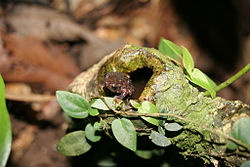| Metaphrynella sundana | |
|---|---|
 | |
| Scientific classification | |
| Kingdom: | Animalia |
| Phylum: | Chordata |
| Class: | Amphibia |
| Order: | Anura |
| Family: | Microhylidae |
| Genus: | Metaphrynella |
| Species: | M. sundana |
| Binomial name | |
| Metaphrynella sundana (Peters, 1867) | |
| Synonyms | |
Calohyla sundanaPeters, 1867 | |
Metaphrynella sundana (Borneo treefrog or Bornean tree hole frog) is a species of frog in the family Microhylidae. It is endemic to Borneo and found in Brunei, Indonesia, and Malaysia. [2]
